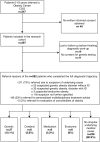Identifying underlying medical causes of pediatric obesity: Results of a systematic diagnostic approach in a pediatric obesity center
- PMID: 32384097
- PMCID: PMC7209105
- DOI: 10.1371/journal.pone.0232990
Identifying underlying medical causes of pediatric obesity: Results of a systematic diagnostic approach in a pediatric obesity center
Erratum in
-
Erratum: Identifying underlying medical causes of pediatric obesity: Results of a systematic diagnostic approach in a pediatric obesity center.PLoS One. 2020 Dec 17;15(12):e0244508. doi: 10.1371/journal.pone.0244508. eCollection 2020. PLoS One. 2020. PMID: 33332451 Free PMC article.
Abstract
Background: Underlying medical causes of obesity (endocrine disorders, genetic obesity disorders, cerebral or medication-induced obesities) are thought to be rare. Even in specialized pediatric endocrinology clinics, low diagnostic yield is reported, but evidence is limited. Identifying these causes is vital for patient-tailored treatment.
Objectives: To present the results of a systematic diagnostic workup in children and adolescents referred to a specialized pediatric obesity center.
Methods: This is a prospective observational study. Prevalence of underlying medical causes was determined after a multidisciplinary, systematic diagnostic workup including growth charts analysis, extensive biochemical and hormonal assessment and genetic testing in all patients.
Results: The diagnostic workup was completed in n = 282 patients. Median age was 10.8 years (IQR 7.7-14.1); median BMI +3.7SDS (IQR +3.3-+4.3). In 54 (19%) patients, a singular underlying medical cause was identified: in 37 patients genetic obesity, in 8 patients cerebral and in 9 patients medication-induced obesities. In total, thirteen different genetic obesity disorders were diagnosed. Obesity onset <5 years (p = 0.04) and hyperphagia (p = 0.001) were indicators of underlying genetic causes, but only in patients without intellectual disability (ID). Patients with genetic obesity with ID more often had a history of neonatal feeding problems (p = 0.003) and short stature (p = 0.005). BMI-SDS was not higher in patients with genetic obesity disorders (p = 0.52). Patients with cerebral and medication-induced obesities had lower height-SDS than the rest of the cohort.
Conclusions: To our knowledge, this is the first study to report the results of a systematic diagnostic workup aimed at identifying endocrine, genetic, cerebral or medication-induced causes of pediatric obesity. We found that a variety of singular underlying causes were identified in 19% of the patients with severe childhood obesity. Because of this heterogeneity, an extensive diagnostic approach is needed to establish the underlying medical causes and to facilitate disease-specific, patient-tailored treatment.
Conflict of interest statement
The authors have declared that no competing interests exist.
Figures


References
Publication types
MeSH terms
LinkOut - more resources
Full Text Sources
Medical

